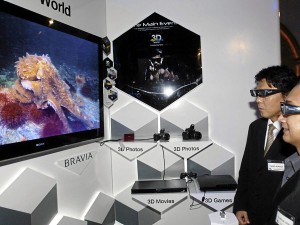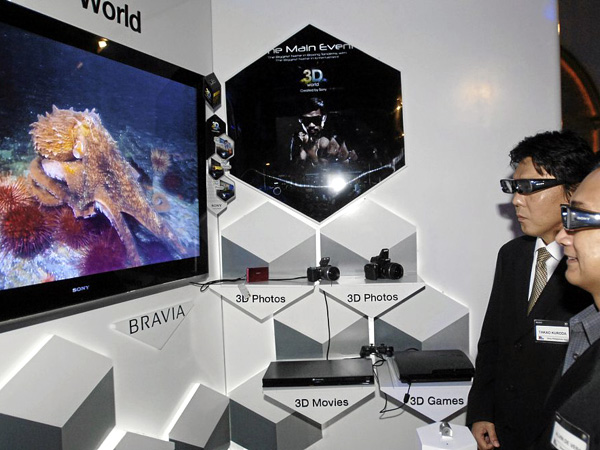
Cutting edge 3D technology is putting new meaning to the phrase “true to life.”
Because of this latest evolution in the viewing experience, images can now be seen in three dimensions – height, length and depth – such that you are tricked into believing that you can actually reach out and touch those people and stuff onscreen. That’s celluloid “augmented reality” for you.
This technology was first mainstreamed in the world of cinema, with blockbuster films such as “Avatar,” “Harry Potter,” “Rio,” “Up” and “Tangled,” but it’s now coming into ordinary homes via the growing line of pricey 3D televisions.
Leading the charge of 3D television in the country is Sony Philippines, a subsidiary of giant entertainment and technology company Sony Corp. of Japan.
According to Larry Secreto, director for Bravia Marketing, sales of Sony 3D televisions have “significantly” increased this year compared to last year, when many consumers were still feeling cautious because of the global economic crisis that peaked in 2009.
Driving this growth of 3D televisions that command five- to six-figure prices depending on the size, are the availability of 3D technology in mid-range models of about 40 inches and the increasing range of content that can be played on the TV set, which come with special glasses to get that full 3D effect.
“There are now more movies, concerts, games and even personal content via 3D Blu Ray players, Playstation 3 and Handycam, Cybershot, Nex and Alpha imaging devices,” says Secreto.
He adds that Sony in the Philippines is intent on pushing for more 3D television sales this year given the warm response to its 3D TV sets and its brand of “lens to the living room” Sony 3D world experience.
It will take some time, however, before 3D television becomes a mainstay in the Philippines. For now, these can mostly be found in the homes of the rich who can afford to shell out six figures for a good-sized 3D television, not to mention the peripherals that have to go with it, such as 3D glasses, Blu Ray disc players and even the latest Sony Playstation model.
What still dominates the television landscape is the cathode ray tube (CRT) television.
However, at the rate that the sales of cathode ray tube televisions are declining in the Philippines and the rest of Southeast Asia, it won’t be long before those bulky sets that demanded their own cabinet will go the way of the betamax, VHS and video cassette recorders.
Fast taking over the CRT TVs’ pride of place in Filipinos’ homes are flat screen Liquid Crystal Display (LCD) television sets that not only occupy far less space –perfect for condominium units and townhouses – but also offer superior picture and sound quality, the better to watch those movies, telenovelas, concerts and basketball matches.
According to the latest survey by market research firm GfK Group, the share of CRT televisions in the Philippines dropped in the first six months of the year to 55 percent, from 71.8 percent in the same period last year. On the other hand, the share of flat screen LCD televisions rose in the same period to 37.6 percent, from 27.1 percent in the first six months last year.
The 55 percent share of CRT television in the Philippines is the second highest among the countries surveyed – Indonesia, Philippines, Thailand, Vietnam, Malaysia and Singapore – next only to Indonesia, where CRT television still accounts for 64.3 percent of TV sales as of June this year, albeit already a big drop from the 84.2 percent figure in the same period last year. Like in the Philippines, LCD TV sales in Indonesia are also rising fast, with LCD TVs now accounting for 29.4 percent of Indonesian TVs as of June, a surge from 14.6 percent recorded at the end of June last year.
A similar trend of upgrading from CRT to LCD televisions is seen in the other major economies that comprise Southeast Asia, with Singapore having no CRT television sets left, as over 99 percent of TV sets there are flat screen using LCD, plasma and more advanced Light Emitting Diode (LED).
According to GfK, the robust sales of LCD televisions in these key economies are driving overall TV sales in the region, where consumers in Indonesia, Malaysia, Philippines, Singapore and Thailand spent over $2.1 billion on 6.33 million television units as of June.
This reflects an overall industry growth of 16 and 11 percent, respectively, in value and volume terms, according to the GfK report that tracked the performance of all segments of the television market from January to June this year.
“The television industry is a vibrant one – innovating and evolving constantly and always presenting consumers with new upgrading options; be it the latest technology or fresh new features,” said Jasmine Lim, regional account director for Consumer Electronics at GfK Asia.
“We are generally seeing an upward growth trending across Southeast Asian markets, particularly in Indonesia and Vietnam, where the value of the TV market registered healthy double digit growth in the first six months of the year, when compared to the same period last year,” Lim said in a statement.
Aside from the skyrocketing sales of LCD TVs, GfK is also seeing increased acceptance of Smart TVs or televisions with access to the Internet.
The report notes that in key countries in Southeast Asia, sales of Smart TVs increased steadily in the first six months, with unit sales in the second quarter growing by 20 percent over the previous quarter.In fact, the overall take-up rate of Smart TVs by consumers in the region in the first six months of the year is 24 of every 100 television units sold, or almost one in every four. Singapore, Thailand and Malaysia are leading the way in the region when it comes to the purchase of Smart TVs.
“Smart TV is relatively new to Southeast Asia consumers, and its future success is directly dependent on the Internet penetration rate and Internet speed of each individual market, which explains why Singapore is currently leading the region in Smart TV adoption,” says Lim.
“Moreover, with the newness of the technology, there’s still much untapped potential and unexplored opportunities – we can expect to see Smart TV continuing to evolve and improve considerably in the near future,” Lim adds.














































